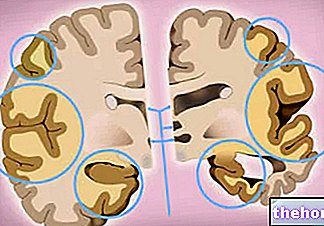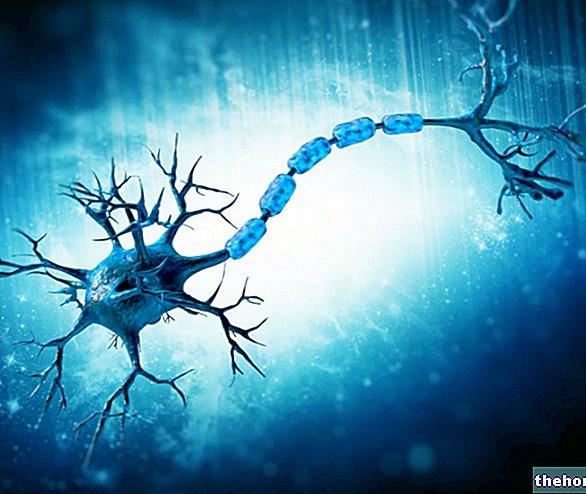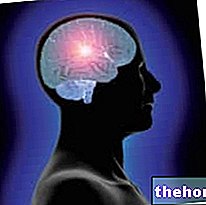Generality
Frontotemporal dementia is a neurodegenerative disease of the brain, which arises due to the progressive deterioration of neurons located in the frontal and temporal lobes of the brain.

Despite the discoveries of the last few decades, the mechanism that leads to the deterioration of neurons still presents some question marks.
Diagnosing frontotemporal dementia is not easy at all and requires several exams and assessment tests.
Unfortunately, as with many other forms of dementia, there is still no cure that will cure or reverse the disease.
What is frontotemporal dementia?
Frontotemporal dementia is a form of dementia that arises as a result of a degeneration of nerve cells (or neurons), located in the frontal and temporal lobes of the brain.
DEFINITION OF DEMENTIA

This reduction has numerous consequences: it interferes with the performance of the simplest daily activities, with interpersonal relationships (ie between people), with the ability to think and memory, with the use of clear and appropriate language, with balance , with the motor muscles, with the behavior, with the personality and with the emotionality.
EPIDEMIOLOGY
Frontotemporal dementia is the fourth most common form of dementia, after the well-known Alzheimer's disease, vascular dementia and dementia with Lewy bodies.
Compared to these diseases just mentioned (which mainly affect the elderly), it tends to arise in younger individuals, generally aged between 40 and 65 years.
It affects both sexes equally.
Causes
The exact mechanism that induces the onset of frontotemporal dementia has only been partially elucidated.
The most recent research, based on analysis post-mortem of patients, revealed that:
- The progressive deterioration of the neurons of the frontal and temporal lobes is subsequent to the formation, within the same cells, of abnormal protein aggregates. By protein aggregates s "we mean small clusters of proteins.
- Among the proteins that make up the aggregates, the most representative and "famous" is tau. Tau is a protein of microtubules, which are small intracellular structures that regulate the transport of fundamental elements within the cell. When tau forms aggregates, the microtubules no longer function adequately and the cell involved dies.
- Frontotemporal dementia can also be a genetic disease passed on from parents to children. At the beginning, it was only hypothesized by the observation that about one third of the patients had a father or mother with the same pathology.
Later it was also demonstrated with the identification of identical genetic mutations in members of the same family, carriers of frontotemporal dementia. - The genes, which, if mutated, predispose to frontotemporal dementia, are at least three: MAPT, GRN and C9ORF72. MAPT resides on chromosome 17 and is involved in the synthesis of the "usual" tau protein; GRN and C9ORF72 reside on chromosome 17 and chromosome 9 respectively and, together, cooperate in the synthesis and proper functioning of a protein called TDP-43.
- Mutations in MAPT, GRN and C9ORF72 induce the accumulation, inside neurons, of the proteins they are associated with, therefore tau and TDP-43.
- For all those cases in which there does not seem to be any familiarity, the appearance of protein aggregates occurs for reasons still unknown.
SUBTYPES OF FRONTEMPORAL DEMENTIA
Thanks also to the scientific discoveries reported in the previous points, the neurodegenerative disease experts have identified 3 subtypes of frontotemporal dementia:
- Pick's disease. Characterized by intracellular clusters of tau protein ("called Pick's bodies"), it appears to be unrelated to any type of hereditary genetic mutation.
In most cases it occurs after the age of 50.
Pick refers to the researcher who first described it, a certain Arnold Pick. - Frontotemporal dementia with parkinsonism, linked to chromosome 17. It is in fact a hereditary disease, characterized by an "alteration of the MAPT gene and by the presence of clusters of tau protein.
- Primary progressive aphasia. Typically onset around the age of 40 and with slow and gradual symptomatological progression, it is only in rare cases associated with hereditary mutations of the MAPT, GRN and C9ORF genes72. unknown.
Symptoms and Complications
Among the various functions performed, the frontal and temporal lobes of the brain also control behavior, language, thinking skills, part of the body's movements and some muscles.
Therefore, the deterioration of their nerve cells leads to a series of symptoms and signs, which mainly refer to these areas.
Frontotemporal dementia has a progressive course. This means that its effects tend to get worse and worse over time (usually over a few years).
N.B: for some patients, the deterioration of neurons may concern only the frontal lobes or only the temporal ones. This leads to an incomplete symptom picture, which depends on the brain area involved.
BEHAVIORAL PROBLEMS
Along with language problems, behavioral problems are the first symptoms to appear in those suffering from frontotemporal dementia.
They can consist of:
- Inappropriate public behavior.
- Impulsiveness.
- Decrease or total loss of inhibitory brakes.
- Neglect of personal hygiene.
- Extreme gluttony, sudden change in food tastes and preferences and inappropriate behaviors at the table (lack of good manners, etc.).
- Irritability and aggression.
- Coldness, indifference and inability to empathize with others.
- Selfish behavior.
- Taking indiscreet or very rude attitudes.
- Repetitive or obsessive behaviors, such as rubbing hands continuously or walking the same path repeatedly and several times a day.
- Loss of enthusiasm and signs of lethargy.
As the disease progresses, the aforementioned disorders worsen and the patient usually tends to isolate himself from the social context and to interrupt any relationship with other people.
LANGUAGE PROBLEMS
Speech problems are very common in those with frontotemporal dementia. They generally consist of:
- Incorrect use of words. For example, a patient might use the word "sheep" in place of the word "dog".
- Reduced vocabulary and difficulty when reading a text.
- Use of a limited number of phrases and tendency to repeat them frequently.
- He struggles to articulate a normal and complete speech.
- Tendency to automatic repetition of phrases or words spoken by other people.
- Conversations and speeches that are increasingly short and poor in content.
As the disease gets worse, patients tend to progressively lose the ability to speak.
Indeed, in the final stages of the disease, they usually become mute.
PROBLEMS WITH THINKING ABILITIES
When frontotemporal dementia impairs thinking skills, patients experience:
- Ease of distraction.
- Poor planning, judgment and organization skills.
- Lack of self-sufficiency. They need to be told, step by step, what to do.
- Rigidity and inflexibility of thought.
- Inability to abstract and understand abstract concepts.
- Memory difficulties.
It should be noted that memory disturbances usually arise at an advanced stage of the disease.
PHYSICAL AND MOVEMENT PROBLEMS
Generally, when it has reached a very advanced stage, frontotemporal dementia impairs the ability to move and control some muscles.
Going into the details of the symptoms, patients can manifest:
- Stiffness similar to that induced by Parkinson's disease.
- Lack of control of the bladder (urinary incontinence) and bowel (fecal incontinence) muscles.
- Progressive weakness associated with muscle wasting (i.e. reduction in muscle mass). In these cases, the sufferer is said to be suffering from one of the so-called motor neuron diseases.
- Difficulty in controlling the limbs of the body, loss of balance and coordination, slow movement and reduced mobility. Doctors identify these disorders with the term cortico-basal degeneration.
- The typical signs of the so-called progressive supranuclear palsy, or disorders in: balance, eye movement and swallowing.
Characteristic symptoms
Pick's disease
Speech problems, difficulty concentrating, impaired thinking faculties, sudden personality changes, abnormal behavior, passivity and lack of tact.
Frontotemporal dementia with parkinsonism, linked to chromosome 17
Stiffness (typical of Parkinson's disease), depression, hallucinations, obsessive behaviors, lack of judgment, problems relating to other people and difficulties with planning and concentration.
Primary progressive aphasia
Personality changes, bizarre behaviors, amnesia, poor attention span, severe speech problems and difficulty reading a text.
Diagnosis
Especially in its early stages, frontotemporal dementia is somewhat difficult to diagnose, as its manifestations can be confused with those of similar diseases or conditions.
In general, the diagnostic process involves the execution of various assessments, including:
- A thorough physical examination. It consists in the analysis of the symptoms and signs, reported or manifested by the patient.
- A neurological exam. It is the evaluation of tendon reflexes, behavior, motor skills, mental faculties and memory skills.
- An "analysis of any drugs taken by the patient under investigation. It is performed because certain drugs produce side effects similar to disorders induced by frontotemporal dementia.
- Blood tests. They are performed to rule out that the symptoms are due to vitamin deficiencies (vitamin B12) or other similar causes.
- Imaging tests, such as CT of the brain or magnetic resonance imaging (MRI) of the brain. CT and MRI of the brain show the appearance and above all the state of health of the various brain areas. In case of frontotemporal dementia, the frontal and temporal lobes show quite evident alterations.
GENETIC TESTS

Treatment
Unfortunately, frontotemporal dementia is a disease that cannot be cured.
However, with some appropriate treatments, it is possible to slow down its progression and alleviate the symptoms.
PHARMACOLOGICAL THERAPY
The pharmacological choice is very small.
The few medicines that are sometimes used are:
- Selective serotonin reuptake inhibitors (SSRIs). Belonging to the category of antidepressants, they are prescribed against the loss of inhibitory brakes and obsessive behaviors.
- Trazodone. It is an antidepressant that can relieve behavioral disorders in some cases.
- Haloperidol. Among the most important antipsychotics, it is rarely prescribed and only in the presence of serious behavior problems, as it can cause serious side effects.
TREATMENTS FOR DEMENTIA PATIENTS
Any patient with dementia - therefore also the individual with frontotemporal dementia - is subjected to this series of symptomatic treatments (ie aimed at relieving symptoms):
- Occupational therapy. It has mainly two objectives: to make the patient as independent as possible from others and to re-insert him into a social context.
- Speech therapy. It aims to at least partially re-establish spoken language and improve communication problems.
- Physiotherapy. It aims to improve motor and balance problems.
- Cognitive stimulation. It consists in making patients perform exercises aimed at improving memory, language and the so-called ability to problem solving.
- Behavioral therapy. It aims to improve the problematic behaviors induced by the disease (extreme gluttony, impulsiveness, etc.).
Prognosis
Since the first symptoms appear, the average life span of a frontotemporal dementia patient is 8 years.




























